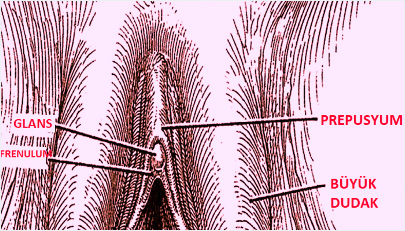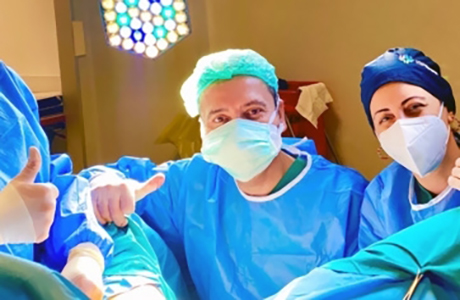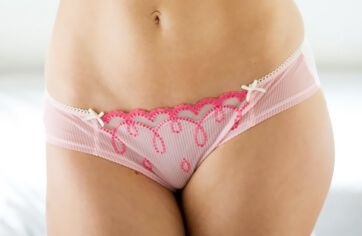Clitoral hoodoplasty is a surgical procedure that reshapes or reduces the clitoral hood, improving appearance and enhancing comfort.
The upper part of the clitoris is called the "clitoral hood". The clitoral hood is the layer of skin that covers the clitoris, just above the labia minora. It is the equivalent of "foreskin" in men. Excess skin in the clitoral hood area reduces the sensitivity of the clitoris, impairs sexual functions, and may cause dissatisfaction in aesthetic appearance. The operation to reduce the skin folds and wrinkles on the clitoris and to reduce this area is called “clitoral hoodoplasty” or “clitoris aesthetics” surgery. Clitoral hoodoplasty is mostly performed simultaneously with labiaplasty operations. In this section, detailed information about “clitoral hoodoplasty surgery techniques” is given.
Where is the clitoral hood area?
The clitoris organ consists of three separate parts as the head, body, and legs. The only part visible from the outside is the head, and this structure is called the "glans clitoridis". The skin that partially covers the head and body of the clitoris is called the "clitoral hood". The clitoral hood is also called the “preputium”. The word hood here means cap or hoodie.
The clitoral hood consists of the fusion of the upper part of the upper skin of both inner lips.

Clitoral hood (Preputium). It partially covers the head and mostly the body of the clitoris.
What is clitoral hoodoplasty?
The surgery to reduce the clitoral hood area aesthetically is called clitoral hoodoplasty surgery. It is also referred to as 'clitoral hoodectomy' or 'clitoral hood resection', or ‘clitoral hood trimming’. Purposes of clitoral hoodoplasty surgery:
- Removal of excess skin tissue over the clitoris,
- Elimination of wrinkles above the clitoris,
- Slight opening of the head of the clitoris (exposition),which is completely embedded in the skin layer,
- Slightly hanging his mound up, which has been hanging down over the years, to give it a younger and more beautiful appearance aesthetically.
It is crucial to apply the clitoral hoodoplasty surgery techniques correctly.
Why is clitoris aesthetics necessary?
Since the clitoral hood is a part of the inner lips, clitoris area aesthetics should be applied simultaneously with the labiaplasty operation. Because in general, if there are excesses on the inner lips, these excesses continue towards the clitoral hood region. Even in unilateral inner lip sagging, there is usually excess skin on the same side of the clitoral margin.
Clitoris area aesthetic operations require more experience!
In our opinion, a physician who is not familiar with different clitoral hoodoplasty surgery techniques should not perform labiaplasty operations. If hoodoplasty operation is not added to the labiaplasty operations, it is seen that a 'micropenis' appearance occurs in the clitoris region, much worse than before. Clitoris area aesthetic operations require more experience than labiaplasty surgeries.
Isolated clitoral hypertrophy
In rare cases, there is excess skin only in the clitoris area, while the structure of the inner lips is normal. This condition is called “isolated clitoral hypertrophy”. In isolated clitoral hypertrophy cases, hoodoplasty alone can be performed without labiaplasty.
Etiology (causes) of larger clitoris hood area
In some patients, the area above the clitoris is larger. These are:
- Most commonly, in revision, patients who have undergone labiaplasty and whose clitoral hood is not trimmed and therefore have aesthetic concerns,
- In isolated hood hypertrophy,
- In cases of pseudoclitoromegaly,
- In cases where the clitoral glans is embedded in diseases such as lichen sclerosis,
- Clitoral hood tumors (rare).
Clitoral Hoodoplasty Surgical Techniques
Several surgical techniques have been proposed in the literature aboutclitoral hoodoplasty.We have also added some of the techniques we used.
Different techniques of clitoral hoodoplasty surgery are listed:
- Bilateral vertical skin excision (Classical method)
- Inverted V-Plasty (Extended central wedge resection)
- Hydrodissection with Inverted V-Plasty
- Reverse Y-Plasty (Inverted-Y plasty, Eserdag)*
- Inverted-U Extended Hoodoplasty, Eserdag
- Hat trimming, Eserdag
- SubepithelialHoodoplasty (Ostrzensky)
* Inverted Y-plasty technique in hoodoplasty, which Dr. Süleyman Eserdağ defined, has also entered the literature under his name.
Risks of clitoral hoodoplasty surgery
Complications such as bleeding, hematoma, severe pain, and edema in the operation area may occur in the acute phase of clitoral hoodoplasty. In the late period, there is a risk of scar formation. The delayed wound healing process, infection, and opening of sutures are factors that increase the risk of scarring. It is an area that needs special attention.
On the other hand, excessive removal of the skin in the clitoral hood area may cause the head of the clitoris to protrude completely, resulting in complaints such as constant stimulation or pain. Therefore, hoodoplasty surgery must be performed very meticulously.
Does clitoral hoodoplasty (clitoral aesthetics) affect sexual sensitivity?
No. When clitoral hoodoplasty or clitoris aesthetic surgeries are applied with the proper technique, removing excess skin in this area will never negatively affect sexual life or sensitivity. Trimming the excess skin over the clitoris can increase sexual arousal even more and provide positive gains on pleasure and orgasm during intercourse. However, the operation should be performed in experienced hands and meticulously.
Postoperative period
Things to do after clitoral hoodoplasty surgery are the same asafter labiaplasty. These are;
- Making dressings regularly for at least seven days
- Intermittent ice compression for three days
- Attention to nutrition
- Not standing too long for 2-3 days
- Attention to hygiene.
In addition, smoking after clitoral hoodoplasty affects wound healing negatively by disrupting the oxygenation of the tissue. You can return to your social life 4-5 days after the operation. There is a prohibition of sexual intercourse for one month.
Clitoral hoodoplasty operations provide many advantages both in aesthetic and in functional aspects when applied by proper technique. As in every surgical operation, the surgeon's experience is extremely important for the operation's success and patient satisfaction.





